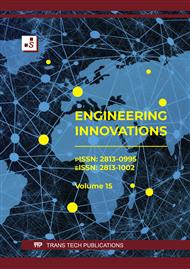[1]
N. Khunrattanaporn, P. Rijiravanich, M. Somasundrum, and W. Surareungchai, "Highly sensitive electrochemical detection of genomic DNA based on stem loop probes structured for magnetic collection and measurement via metalised hollow polyelectrolyte shells," Biosens. Bioelectron., vol. 73, p.181–187, 2015.
DOI: 10.1016/j.bios.2015.05.068
Google Scholar
[2]
M. Xu, R. Wang, and Y. Li, "Electrochemical biosensors for rapid detection of Escherichia coli O157: H7," Talanta, vol. 162, p.511–522, 2017.
DOI: 10.1016/j.talanta.2016.10.050
Google Scholar
[3]
T. Saxena, P. Kaushik, and M. Krishna Mohan, "Prevalence of E. coli O157: H7 in water sources: An overview on associated diseases, outbreaks and detection methods," Diagn. Microbiol. Infect. Dis., vol. 82, no. 3, p.249–264, 2015.
DOI: 10.1016/j.diagmicrobio.2015.03.015
Google Scholar
[4]
B. Thakur et al., "Rapid detection of single E. coli bacteria using a graphene-based field-effect transistor device," Biosens. Bioelectron., vol. 110, p.16–22, 2018.
DOI: 10.1016/j.bios.2018.03.014
Google Scholar
[5]
N. Shoaie, M. Forouzandeh, and K. Omidfar, "Voltammetric determination of the Escherichia coli DNA using a screen-printed carbon electrode modified with polyaniline and gold nanoparticles," Microchim. Acta, vol. 185, no. 4, pp.1-9, 2018.
DOI: 10.1007/s00604-018-2749-y
Google Scholar
[6]
C. Song, J. Li, J. Liu, and Q. Liu, "Simple sensitive rapid detection of Escherichia coli O157:H7 in food samples by label-free immunofluorescence strip sensor," Talanta, vol. 156–157, p.42–47, 2016.
DOI: 10.1016/j.talanta.2016.04.054
Google Scholar
[7]
Y. Luo and E. C. Alocilja, "Portable nuclear magnetic resonance biosensor and assay for a highly sensitive and rapid detection of foodborne bacteria in complex matrices," J. Biol. Eng., vol. 11, no. 1, p.1–8, 2017.
DOI: 10.1186/s13036-017-0053-8
Google Scholar
[8]
M. Nur et al., "Conductometric immunosensor for specific Escherichia coli O157 : H7 detection on chemically funcationalizaed interdigitated aptasensor," Heliyon, vol. 10, no. 5, p. e26988, 2024.
DOI: 10.1016/j.heliyon.2024.e26988
Google Scholar
[9]
U. Hashim et al., "Advancing COVID-19 Detection: High-Performance RNA Biosensing via Electrical Interactions," Int. J. Nanoelectron. Mater., vol. 17, no. June Special issue, p.229–235, 2024.
DOI: 10.58915/ijneam.v17iJune.862
Google Scholar
[10]
M. N. Afnan Uda et al., "Aluminium Interdigitated Electrode with 5.0 µm Gap for Electrolytic Scooting," Int. J. Nanoelectron. Mater., vol. 17, no. Special issue, p.237–243, 2024.
DOI: 10.58915/ijneam.v17iJune.863
Google Scholar
[11]
M. N. Afnan Uda, A. B. Jambek, U. Hashim, and M. N. A. Uda, "Development of Voltage Amplifier Electronic Reader for Multiplex Detection of Two Electrode Electrical Biosensors," IOP Conf. Ser. Mater. Sci. Eng., vol. 743, no. 1, 2020.
DOI: 10.1088/1757-899X/743/1/012019
Google Scholar
[12]
M. Isa et al., "Arthropods-mediated Green Synthesis of Zinc Oxide Nanoparticles using Cellar Spider Extract: A Biocompatible Remediation for Environmental Approach," Int. J. Nanoelectron. Mater., vol. 17, no. Special Issue, p.211–219, 2024.
DOI: 10.58915/ijneam.v17iJune.860
Google Scholar
[13]
M. N. Afnan Uda et al., "Nano-micro-mili Current to Mili Voltage Amplifier for Amperometric Electrical Biosensors," IOP Conf. Ser. Mater. Sci. Eng., vol. 743, no. 1, 2020.
DOI: 10.1088/1757-899X/743/1/012021
Google Scholar
[14]
J. L. Soler-Llorens, J. J. Galiana-Merino, J. Giner-Caturla, P. Jauregui-Eslava, S. Rosa-Cintas, and J. Rosa-Herranz, "Development and programming of Geophonino: A low cost Arduino-based seismic recorder for vertical geophones," Comput. Geosci., vol. 94, p.1–10, 2016.
DOI: 10.1016/j.cageo.2016.05.014
Google Scholar
[15]
I. Luiz, B. De Moura, L. Carlos, D. S. Monteiro, and F. A. Soares, "Low Cost Surface Electromyographic Signal Amplifier Based On Arduino Microcontroller," Int. J. Electr. Robot. Electron. Commun. Eng., vol. 8, no. 2, p.310–314, 2014.
Google Scholar
[16]
O. A. Olumodeji and M. Gottardi, "Arduino-controlled HP memristor emulator for memristor circuit applications," Integr. VLSI J., vol. 58, no. March, p.438–445, 2017.
DOI: 10.1016/j.vlsi.2017.03.004
Google Scholar
[17]
M. N. A. Uda et al., "Harumanis Mango: Perspectives in Disease Management and Advancement using Interdigitated Electrodes (IDE) Nano-Biosensor," IOP Conf. Ser. Mater. Sci. Eng., vol. 864, no. 1, 2020.
DOI: 10.1088/1757-899X/864/1/012180
Google Scholar
[18]
L. O. Agbolade et al., "Revisiting the Optoelectronic Properties of Graphene: A DFT Approach," Int. J. Nanoelectron. Mater., vol. 17, no. 1, p.76–88, 2024.
DOI: 10.58915/ijneam.v17i1.476
Google Scholar
[19]
M. N. A. Uda, U. Hashim, S. C. B. Gopinath, M. N. A. Uda, N. A. Parmin, and A. M. Isa, "Label-free aptamer based biosensor for heavy metal detection," AIP Conf. Proc., vol. 2291, no. November, 2020.
DOI: 10.1063/5.0022834
Google Scholar
[20]
J. M. Ismail et al., "Synthesis of Zinc Oxide Nanoparticles via Cellar Spider Extract for Enhanced Functional Properties in Antimicrobial Activities," Int. J. Nanoelectron. Mater., vol. 17, no. June Special issue, p.203–210, 2024.
DOI: 10.58915/ijneam.v17iJune.856
Google Scholar
[21]
M. N. A. Uda et al., "Analysis on Silica and Graphene Nanomaterials Obtained From Rice Straw for Antimicrobial Potential," Int. J. Nanoelectron. Mater., vol. 17, no. Special issue, p.221–228, 2024.
DOI: 10.58915/ijneam.v17iJune.861
Google Scholar
[22]
M. N. Afnan Uda, A. B. Jambek, U. Hashim, and M. N. A. Uda, "Electrical DNA Biosensor Using Aluminium Interdigitated Electrode for Salmonella Detection," IOP Conf. Ser. Mater. Sci. Eng., vol. 743, no. 1, 2020.
DOI: 10.1088/1757-899X/743/1/012022
Google Scholar


